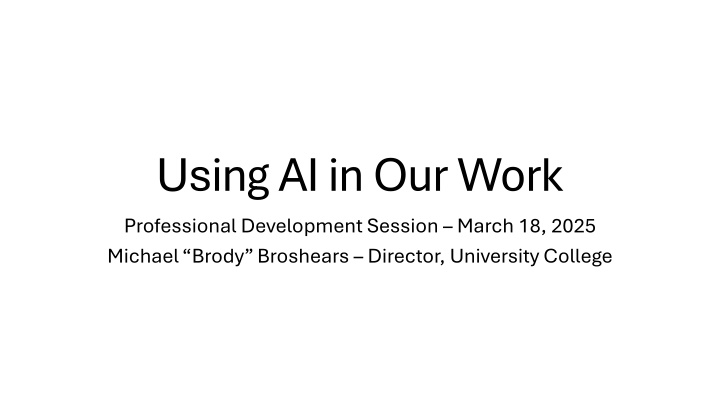
Exploring AI in the Workplace: Trends, Challenges, and Adoption
Dive into the world of AI in professional settings, uncovering concerns, excitement, and real-life applications. Learn about the current state of AI integration in various industries, employee perceptions, and strategies to enhance AI adoption in the workplace.
Uploaded on | 3 Views
Download Presentation

Please find below an Image/Link to download the presentation.
The content on the website is provided AS IS for your information and personal use only. It may not be sold, licensed, or shared on other websites without obtaining consent from the author. If you encounter any issues during the download, it is possible that the publisher has removed the file from their server.
You are allowed to download the files provided on this website for personal or commercial use, subject to the condition that they are used lawfully. All files are the property of their respective owners.
The content on the website is provided AS IS for your information and personal use only. It may not be sold, licensed, or shared on other websites without obtaining consent from the author.
E N D
Presentation Transcript
Using AI in Our Work Professional Development Session March 18, 2025 Michael Brody Broshears Director, University College
What makes you nervous about AI? What excites you about AI? Introduction Questions How have you used AI in your work? Personal Life? If you ve yet to use AI tools in your work, why?
Goals for todays session Provide an overview of AI s role in student support services like advising, financial aid, admissions, and academic support Highlight broader trends for AI and the workplace Understanding the functions and uses of AI tools that can be leveraged in Higher Education See real life examples of AI in action Begin getting hands on experience with AI-powered platforms for communication predictive analytics, and student engagement
AI in the Workplace November 2022, Open AI launched ChatGPT Some stats: Industries Only a third (33%) of all US employees say their organization has begun integrating AI into their business practices White collar industries that number rises to 44% Employees Two thirds of employees say they have never used AI in their role (54% of white collar) Only one in 10 say they are using AI at least weekly (15% of white collar) These figures remained essentially unchanged from 2023 to 2024 WHAT will move the needle here? Gallup. (2024, October 8). AI in the workplace: Answering 3 big questions. Gallup. https://www.gallup.com/workplace/651203/workplace-answering-big-questions.aspx
Improving AI Adoption Few employees feel prepared to use AI in their roles Only 6% of employees feel very comfortable using AI in their roles 16% of employees say they are very or somewhat comfortable using AI 32% said they were very uncomfortable using AI in their roles From 2023 to 2024 the number of employees who said they are very prepared to work with AI dropped by six percentage points Gallup. (2024, October 8). AI in the workplace: Answering 3 big questions. Gallup. https://www.gallup.com/workplace/651203/workplace-answering-big-questions.aspx
Gallup. (2024, October 8). AI in the workplace: Answering 3 big questions. Gallup. https://www.gallup.com/workplace/651203/workplace-answering-big-questions.aspx
Employees that use AI find it helpful Gallup. (2024, October 8). AI in the workplace: Answering 3 big questions. Gallup. https://www.gallup.com/workplace/651203/workplace- answering-big-questions.aspx
Three key strategies for improving AI Adoption Clearly Clearly established guidance for AI use Training aligned with employees roles communicated plan for integration
Improving AI Adoption, continued Understand the source of the confidence gap Start small and stay focused Decide how you want to deploy AI in your work and practice Reeves, E., & Chase, A. (2025, February 4). Three ways to help faculty feel more confident about AI. Inside Higher Ed. https://www.insidehighered.com/opinion/career- advice/teaching/2025/02/04/three-ways-help-faculty-feel-more- confident-about-ai
In March 13, 2025, Inside Higher Ed article, Northern Arizona president highlighted how he came to use AI in academic leadership: Drafting responses to routine emails Analyzes past student performance data and created quizzes designed to assess specific learning outcomes Brainstormed ways to present complex concepts linking course material to Gen Z cultural touch points Speechwriting Team management (conflicting viewpoints upload to get to shared values) Personal usage Leaders need to lead by example Cruz Rivera, J. L. (2025, March 13). A president s journey to AI adoption. Inside Higher Ed. Retrieved from https://www.insidehighered.com/opinion/career-advice/advancing- administrator/2025/03/13/presidents-journey-ai-adoption- opinion[1](https://www.insidehighered.com/opinion/career-advice/advancing- administrator/2025/03/13/presidents-journey-ai-adoption-opinion)
59% of students use AI tools at least once a month, showing promise as a catalyst to address advisor capacity challenges AI tool usage amongst frontline support providers is lagging, with 49% of academic advisors and counselors having never used these tools Only 11% of administrators and advisors say their student success data is ready to seed generative AI models. Though generative AI can supplement limited advisor capacity, most institutions are unprepared to leverage it for student success, despite some targeted implementations https://tytonpartners.com/driving-toward-a- degree-2024/ The Challenges for Advising
Implementing generative AI for academic planning can potentially save advising meeting time spent on the technical aspects of course registration, enabling more holistic advising conversations. Tyton s survey also found, among advisers, helping students select courses or a plan of study was the top daily activity, with 95 percent of academic advisers and 59 percent of faculty advisers selecting this option. BUT, Over half of first-year students believe they could select the right courses each term, and 60 percent of students beyond their first year agree with this, as well. https://tytonpartners.com/driving-toward-a-degree-2024/ The Challenges for Advising
AI Use and Academic Advising EAB Article Research done by Sam Rittenberg Wanted to learn: What activities take up most of an advisor s time when meeting with students Are advisors spending time on activities they think are most impactful? Would advisors redistribute their time to have a greater impact if they could?
Results Advisors wanted to spend >50% less time on transactional activities like Course Selection and Schedule Creation Advisors would like to redistribute that time on longer-term strategic activities like Goal Setting & Planning, Academic Coaching, Personal Coaching Rittenberg, Sam. Advisors Want to Spend 50% Less Time on These Activities. EAB, 12 Apr. 2018, www.eab.com/blogs/student-success-insights/2018/04/advisors-want-to-spend-less-time-on-these- activities
And, the research supports this idea for advisors Advising, at its core, is about supporting and facilitating the career and academic development of the students we serve. Appreciative Inquiry, Developmental Advising, Advocacy Advising, Advising as Teaching all operate with the STUDENT at the center (interactive process, relationship driven, with both the advisor and student benefitting from the process) Concept of congruence, positive regard, and empathy Hughey, Judy K. Strategies to Enhance Interpersonal Relations in Academic Advising. NACADA Journal, vol. 31, no. 2, 2011, pp. 22 32., doi:10.12930/0271-9517-31.2.22.
Tools supported by ChatGPT is best for text-based tasks (summaries, responses, content creation) ISU Microsoft Co-Pilot excels in workflow automation and productivity (emails, reports, scheduling) Key Takeaways: Adobe Firefly is ideal for visual content creation (flyers, graphics, social media visuals) Zoom AI enhances meeting efficiency with automated transcription and note-taking
Tool Primary Function Best Uses in Higher Ed Key Features Integration Strong natural language processing (NLP), coding capabilities, text-based assistance Advising emails, student FAQs, policy summaries, content creation Standalone app, integrates with Microsoft via Azure Conversational AI, Text Generation ChatGPT (OpenAI) Embedded in Microsoft 365 (Word, Excel, Teams, Outlook), AI-powered writing and analysis Meeting summaries, document drafting, email automation, data insights Productivity AI for MS Office Fully integrated into Microsoft ecosystem Microsoft Co-Pilot AI-generated images, text- to-image capabilities, graphic design automation Creating visuals for advising, marketing, recruitment materials Works within Adobe Creative Cloud (Photoshop, Illustrator) AI for Image & Content Creation Adobe Firefly Transcribing advising sessions, summarizing student meetings, auto- generating follow-ups AI-powered transcription, action item tracking, automated note-taking Meeting Summarization & Productivity Integrated into Zoom meetings Zoom AI
Responsible Use of AI Link https://about.illinoisstate.edu/ai/using-ai-at-isu/
Examples of Brody Use Elementary Education Four-Year Plan Thrive Feedback Summary Email to student in academic difficulty Advising/Registration Schedule Opening a record store
Questions, thoughts, suggestions Michael Brody Broshears Director, University College Illinois State University mabros1@ilstu.edu




















